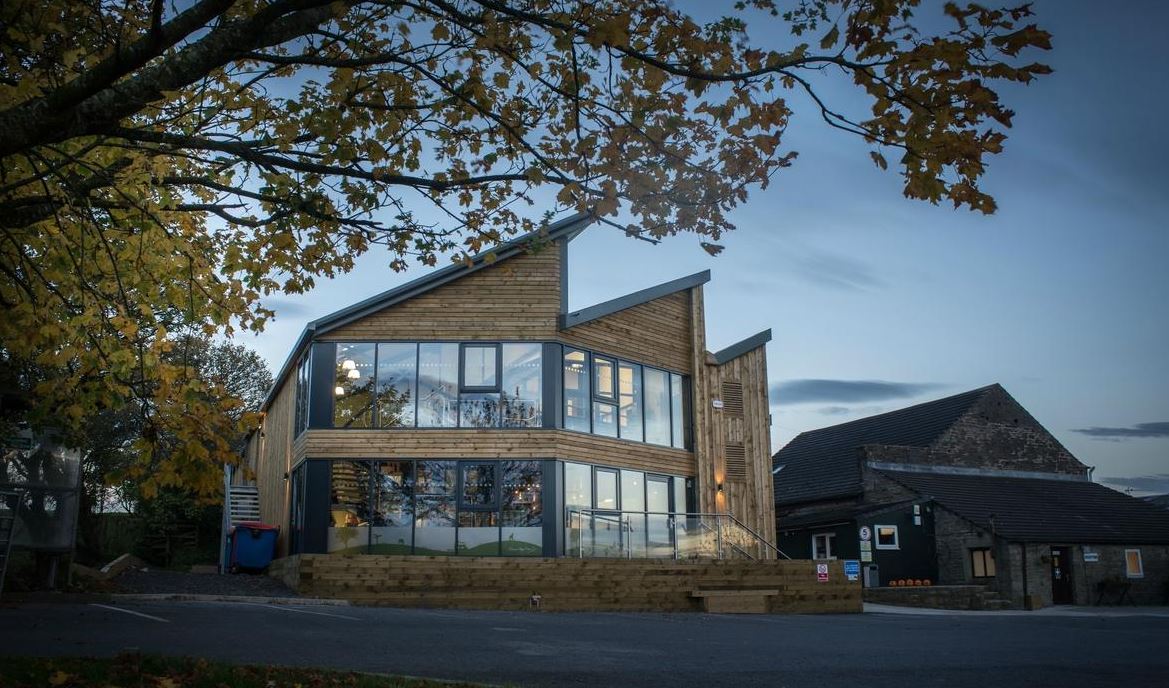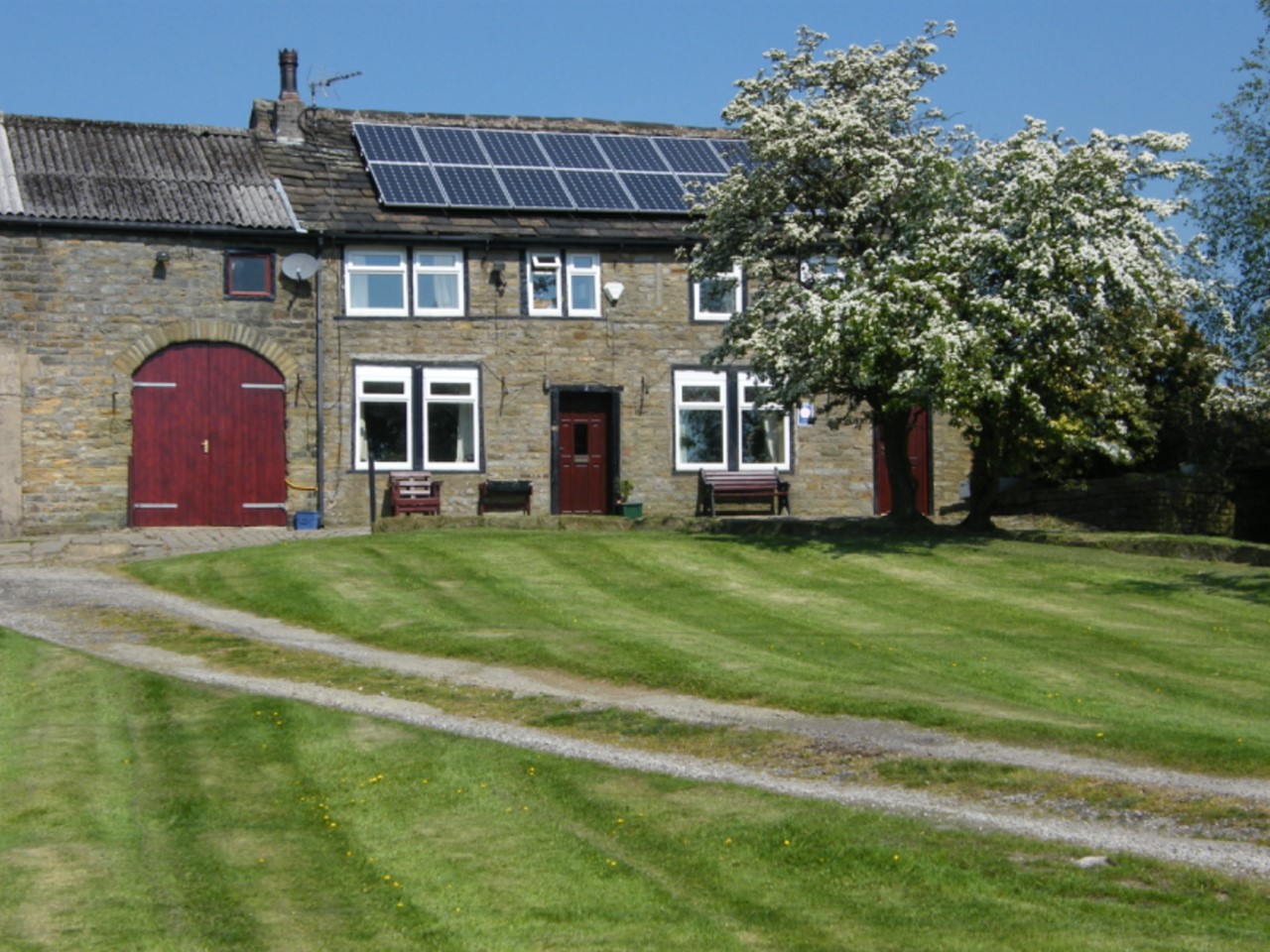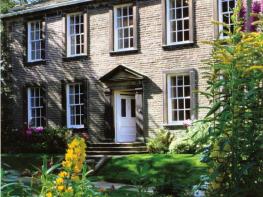Comfortable, tastefully furnished and close to the town centre in Todmorden, the Green Route…
The Bridestone Rocks from Lydgate

Ancient tracks and gritstone outcrops, with terrific views of the steep-sided Cliviger Valley.
6.25 miles (10.1kms)
About the walk
The Long Causeway, between Halifax and Burnley, is an ancient trading route, possibly dating back to the Bronze Age. Crosses and waymarker stones helped to guide travellers across the moorland wastes, though most of them have been lost or damaged in the intervening years. Amazingly, Mount Cross has survived intact: a splendid, though crudely carved, example of the Celtic 'wheel-head' design. Opinions differ about its age but it is certainly the oldest man-made artefact in the area, erected at least a thousand years ago.
The Bridestones
The hills and moors to the north of Todmorden are dotted with gritstone outcrops. The impressive piles of Orchan Rocks and Whirlaw Stones are both encountered on this walk. But the most intriguing rock formations are to be found at the Bridestones. One rock in particular has been weathered by wind and water into a teardrop shape, and stands on a base that looks far too slender to support its great weight. It resembles a rock in the North York Moors National Park, which is also known as the Bridestone.
Wind Power
Further along the edge to the northwest, and well placed to catch the winds funnelled along the valley are the tall turbines of Coal Clough Windfarm. With a capacity of around 9.6 megawatts, enough to power around 5,500 homes, it was opened in 1992 and was one of the first such schemes to be commissioned in this country. It is now (2013) reaching the end of its life and it is planned to replace the 24 existing turbines with eight much bigger structures, capable of producing 16 megawatts.
Cliviger Valley
The Cliviger Valley links two towns – Todmorden in West Yorkshire and Burnley in Lancashire – that expanded with the textile trade, and then suffered when that trade went into decline. The valley itself is narrow and steep-sided, in places almost a gorge. Into the cramped confines of the valley are shoehorned the road, railway line, the infant River Calder and communities such as Portsmouth, Cornholme and Lydgate that grew up around the textile mills. The mills were powered by fast-flowing becks, running off the steep hillsides. The valley is almost a microcosm of the Industrial Revolution: by no means beautiful, but full of character. This area is particularly well provided with good footpaths, some of them still paved with their original causeway stones.
Walk directions
From the post office in Lydgate, take Church Road. At the end go right into Owlers Walk and continue along a contained path. Meeting a track at its end, follow it beneath a railway bridge and up to Stannally Farm. Walk past the buildings and swing right as the track zigzags steeply up the wooded hillside. Eventually breaking out onto the edge of open moor it swings right towards a farm. Pass left of the farmhouse and then bear left up a narrower walled track. When you meet another walled track, go right towards a rocky outcrop on the first horizon. Beyond two gates, the path crosses onto the rough common that aprons Whirlaw Stones.
A causeway path skirts the base of the outcrop giving panoramic views of the Cliviger Valley, Todmorden and Stoodley Pike. Keep going through gates until you reach a junction above East Whirlaw Farm. There turn sharp left along a stony track that winds up beside the outcrop to meet the end of Windy Harbour Lane. Carry on up the lane, which shortly leads to Eastwood Road. Go left for just 150yds (137m). Where the wall ends, take a kissing gate on the left. A grassy path leads you to another fascinating collection of rocks, known as the Bridestones.
Continue past the Bridestones across a landscape of scattered boulders. Keep ahead, dropping to cross a ruined wall. Continue ahead past wayposts, the path curving above the edge and eventually falling to a gate and stile. Follow a track right out to a lane.
Go left, along the road for 0.75 miles (1.2km), passing below the Hawks Stones on the right and a handful of houses, until you come to a minor road on the left. This is Mount Lane, signed to Shore. Walk down for 300yds (274m) before turning left on to a broad bridleway. Look out for Mount Cross, which stands a short way along, over the wall in a field to your left.
Bear left past Lower Intake Farm on a path that soon resumes as a track. Cross an intersecting track and, later, a bridge spanning a stream before reaching a stile, 250yds (229m) further along on the right. Ignore the stile, but take the adjacent track, which drops alongside a wall past another gritstone outcrop, Orchan Rocks.
Where the wall bears left, beyond the rocks, follow it downhill to a stile. You now join a farm track that makes a serpentine descent through woodland back to Lydgate. Reaching the former Board School, now the Robin Wood Activity Centre, turn sharp left back to the main road.
Additional information
Moorland and packhorse paths, some quiet roads, several stiles
Steep-sided valley and open moorland
Keep on lead along lanes and near grazing sheep
OS Explorer OL21 South Pennines
Roadside parking in Lydgate, 1.5 miles (2.4km) out of Todmorden, on A646, signposted to Burnley
None on route
WALKING IN SAFETY
Read our tips to look after yourself and the environment when following this walk.
Find out more
Also in the area
About the area
Discover West Yorkshire
Everybody knows that Yorkshire has some special landscapes. The Dales and the Moors first spring to mind, but what about West Yorkshire? That’s Leeds and Bradford isn’t it? Back-to-back houses and blackened mills… Certainly if you had stood on any of the hills surrounding Hebden Bridge a hundred years ago, and gazed down into the valley, all you would have seen was the pall of smoke issuing from the chimneys of 33 textile mills. But thankfully, life changes very quickly in West Yorkshire. The textile trade went into terminal decline, the mills shut down forever and in a single generation Hebden Bridge became a place that people want to visit.
The surrounding countryside offers walking every bit as good as the more celebrated Yorkshire Dales; within minutes you can be tramping across the moors. And this close proximity of town and country is repeated all across West Yorkshire. There’s such diversity in the area that you can find yourself in quite unfamiliar surroundings, even close to places you may know very well. Take time to explore this rich county and you will be thrilled at what you find to shatter old myths and preconceptions.
Nearby stays
Restaurants and Pubs
Nearby experiences
Recommended things to do
Why choose Rated Trips?
Your trusted guide to rated places across the UK
The best coverage
Discover more than 15,000 professionally rated places to stay, eat and visit from across the UK and Ireland.
Quality assured
Choose a place to stay safe in the knowledge that it has been expertly assessed by trained assessors.
Plan your next trip
Search by location or the type of place you're visiting to find your next ideal holiday experience.
Travel inspiration
Read our articles, city guides and recommended things to do for inspiration. We're here to help you explore the UK.













